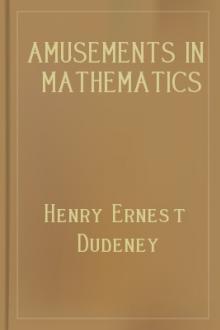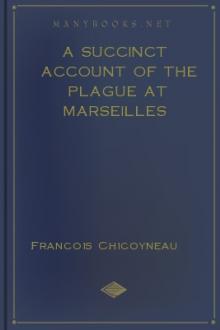Amusements in Mathematics, Henry Ernest Dudeney [books to read to be successful txt] 📗

- Author: Henry Ernest Dudeney
- Performer: 0486204731
Book online «Amusements in Mathematics, Henry Ernest Dudeney [books to read to be successful txt] 📗». Author Henry Ernest Dudeney

I have recorded a large number of solutions with four queens and a rook, or bishop, but the only arrangement, I believe, with three queens and two rooks in which all the pieces are guarded is that of which I give an illustration (Fig. 4), first published by Dr. C. Planck. But I have since found the accompanying solution with three queens, a rook, and a bishop, though the pieces do not protect one another. (Fig. 5.)


314.—THE SOUTHERN CROSS.—solution
My readers have been so familiarized with the fact that it requires at least five planets to attack every one of a square arrangement of sixty-four stars that many of them have, perhaps, got to believe that a larger square arrangement of stars must need an increase of planets. It was to correct this possible error of reasoning, and so warn readers against another of those numerous little pitfalls in the world of puzzledom, that I devised this new stellar problem. Let me then state at once that, in the case of a square arrangement of eighty one stars, there are several ways of placing five planets so that every star shall be in line with at least one planet vertically, horizontally, or diagonally. Here is the solution to the "Southern Cross": —

It will be remembered that I said that the five planets in their new positions "will, of course, obscure five other stars in place of those at present covered." This was to exclude an easier solution in which only four planets need be moved.
315.—THE HAT-PEG PUZZLE.—solution
The moves will be made quite clear by a reference to the diagrams, which show the position on the board after each of the four moves. The darts indicate the successive removals that have been made. It will be seen that at every stage all the squares are either attacked or occupied, and that after the fourth move no queen attacks any other. In the case of the last move the queen in the top row might also have been moved one square farther to the left. This is, I believe, the only solution to the puzzle.

316.—THE AMAZONS.—solution
It will be seen that only three queens have been removed from their positions on the edge of the board, and that, as a consequence, eleven squares (indicated by the black dots) are left unattacked by any queen. I will hazard the statement that eight queens cannot be placed on the chessboard so as to leave more than eleven squares unattacked. It is true that we have no rigid proof of this yet, but I have entirely convinced myself of the truth of the statement. There are at least five different ways of arranging the queens so as to leave eleven squares unattacked.

317.—A PUZZLE WITH PAWNS.—solution
Sixteen pawns may be placed so that no three shall be in a straight line in any possible direction, as in the diagram. We regard, as the conditions required, the pawns as mere points on a plane.

318.—LION-HUNTING.—solution
There are 6,480 ways of placing the man and the lion, if there are no restrictions whatever except that they must be on different spots. This is obvious, because the man may be placed on any one of the 81 spots, and in every case there are 80 spots remaining for the lion; therefore 81 × 80 = 6,480. Now, if we deduct the number of ways in which the lion and the man may be placed on the same path, the result must be the number of ways in which they will not be on the same path. The number of ways in which they may be in line is found without much difficulty to be 816. Consequently, 6,480 - 816 = 5,664, the required answer.
The general solution is this: 1/3n(n - 1) (3n2 - n + 2). This is, of course, equivalent to saying that if we call the number of squares on the side of a "chessboard" n, then the formula shows the number of ways in which two bishops may be placed without attacking one another. Only in this case we must divide by two, because the two bishops have no distinct individuality, and cannot produce a different solution by mere exchange of places.
319.—THE KNIGHT-GUARDS.—solution


The smallest possible number of knights with which this puzzle can be solved is fourteen.
It has sometimes been assumed that there are a great many different solutions. As a matter of fact, there are only three arrangements—not counting mere reversals and reflections as different. Curiously enough, nobody seems ever to have hit on the following simple proof, or to have thought of dealing with the black and the white squares separately.



Seven knights can be placed on the board on white squares so as to attack every black square in two ways only. These are shown in Diagrams 1 and 2. Note that three knights occupy the same position in both arrangements. It is therefore clear that if we turn the board so that a black square shall be in the top left-hand corner instead of a white, and place the knights in exactly the same positions, we shall have two similar ways of attacking all the white squares. I will assume the reader has made the two last described diagrams on transparent paper, and marked them 1a and 2a. Now, by placing the transparent Diagram 1a over 1 you will be able to obtain the solution in Diagram 3, by placing 2a over 2 you will get Diagram 4, and by placing 2a over 1 you will get Diagram 5. You may now try all possible combinations of those two pairs of diagrams, but you will only get the three arrangements I have given, or their reversals and reflections. Therefore these three solutions are all that exist.
320.—THE ROOK'S TOUR.—solution

The only possible minimum solutions are shown in the two diagrams, where it will be seen that only sixteen moves are required to perform the feat. Most people find it difficult to reduce the number of moves below seventeen.

321.—THE ROOK'S JOURNEY.—solution

I show the route in the diagram. It will be seen that the tenth move lands us at the square marked "10," and that the last move, the twenty-first, brings us to a halt on square "21."
322.—THE LANGUISHING MAIDEN.—solution
The dotted line shows the route in twenty-two straight paths by which the knight may rescue the maiden. It is necessary, after entering the first cell, immediately to return before entering another. Otherwise a solution would not be possible. (See "The Grand Tour," p. 200.)

323.—A DUNGEON PUZZLE.—solution
If the prisoner takes the route shown in the diagram—where for clearness the doorways are omitted—he will succeed in visiting every cell once, and only once, in as many as fifty-seven straight lines. No rook's path over the chessboard can exceed this number of moves.

324.—THE LION AND THE MAN.—solution
First of all, the fewest possible straight lines in each case are twenty-two, and in order that no cell may be visited twice it is absolutely necessary that each should pass into one cell and then immediately "visit" the one from which he started, afterwards proceeding by way of the second available cell. In the following diagram the man's route is indicated by the unbroken lines, and the lion's by the dotted lines. It will be found, if the two routes are followed cell by cell with two pencil points, that the lion and the man never meet. But there was one little point that ought not to be overlooked—"they occasionally got glimpses of one another." Now, if we take one route for the man and merely reverse it for the lion, we invariably find that, going at the same speed, they never get a glimpse of one another. But in our diagram it will be found that the man and the lion are in the cells marked A at the same moment, and may see one another through the open doorways; while the same happens when they are in the two cells marked B, the upper letters indicating the man and the lower the lion. In the first case the lion goes straight for the man, while the man appears to attempt to get in the rear of the lion; in the second case it looks suspiciously like running away from one another!

325.—AN EPISCOPAL VISITATION.—solution

In the diagram I show how the bishop may be made to visit every one of his white parishes in seventeen moves. It is obvious that we must start from one corner square and end at the one that is diagonally opposite to it. The puzzle cannot be solved in fewer than seventeen moves.
326.—A NEW COUNTER PUZZLE.—solution
Play as follows: 2—3, 9—4, 10—7, 3—8, 4—2, 7—5, 8—6, 5—10, 6—9, 2—5, 1—6, 6—4, 5—3, 10—8, 4—7, 3—2, 8—1, 7—10. The white counters have now changed places with the red ones, in eighteen moves, without breaking the conditions.
327.—A NEW BISHOP'S PUZZLE.—solution

Play as follows, using the notation indicated by the numbered squares in Diagram A:—
Diagram B shows the position after the ninth move. Bishops at 1 and 20 have not yet moved, but 2 and 19 have sallied forth and returned. In the end, 1 and 19, 2 and 20, 3 and 17, and 4 and 18 will have exchanged places. Note the position after the thirteenth move.
328.—THE QUEEN'S TOUR.—solution

The annexed diagram shows a second way of performing the Queen's Tour. If you break the line at the point J and erase the shorter portion of that line, you will have the required path solution for any J square. If you break the line at I, you will have a non-re-entrant solution starting from any I square. And if





Comments (0)